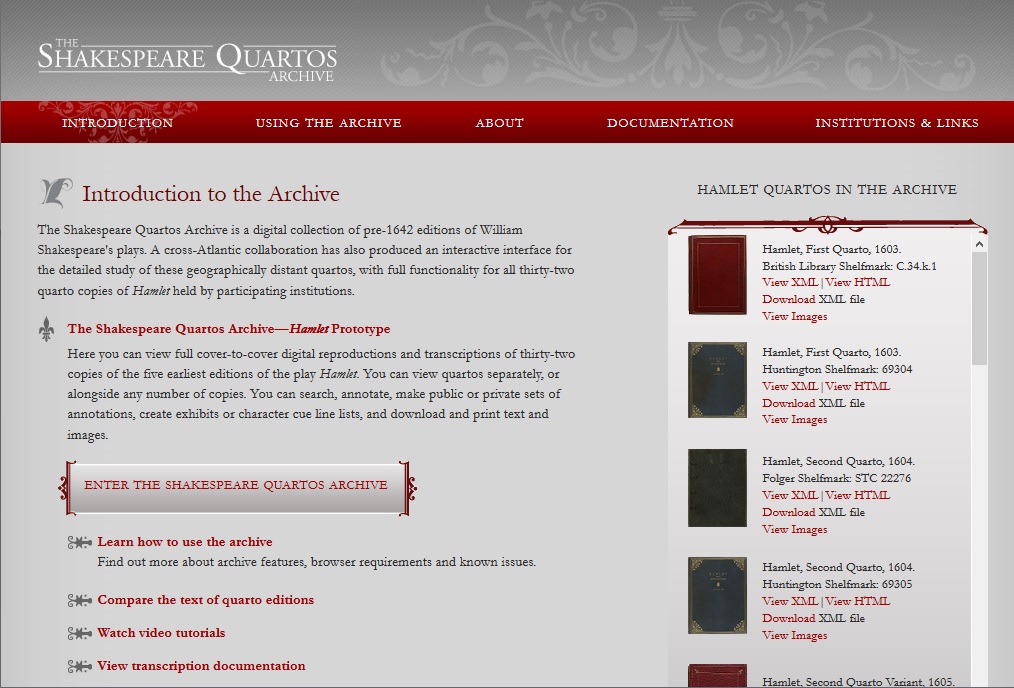
We regret to inform users that this resource is no longer available. The site has been withdrawn as the technologies which it is built with have reached end-of-life.
An archived version of the site is available at https://wayback.archive-it.org/org-467/20191016094633/http://quartos.org/
Last update to original site:
2009
Date withdrawn:
15 April 2020
Please contact digitalsupport@bodleian.ox.ac.uk with any questions.
Preface from the original site
The Shakespeare Quartos Archive is a digital collection of pre-1642 editions of William Shakespeare's plays. A cross-Atlantic collaboration has also produced an interactive interface for the detailed study of these geographically distant quartos, with full functionality for all thirty-two quarto copies of Hamlet held by participating institutions.
About the Shakespeare Quartos Archive
History of the quartos
The earliest Shakespeare quartos are over four hundred years old and constitute the rarest, most fragile body of printed literature available to Shakespeare scholars. Sold unbound and often read to pieces, they are among the most ephemeral books of the age and survive in relatively low numbers. In the absence of surviving manuscripts, the quartos offer the earliest known evidence of what Shakespeare might actually have written, and what appeared on the early modern English stage. Only about half of Shakespeare’s plays were printed in quarto during his lifetime (1564–1616), and before the first printed collection of his plays, the First Folio of 1623. They are living artifacts telling the story of how Shakespeare's Hamlet, Henry V, King Lear, A Midsummer Night's Dream, and Romeo and Juliet, to name just a few, first circulated in print. Scholars, teachers, editors, and theatre directors, therefore, seek to examine these books for historical evidence and for significant variations in text. Over the centuries, generations of collectors have held these unassuming treasures in private collections, then donated or sold them to public institutions, rare book libraries, or other individuals. This pattern of trade over four centuries has dispersed the body of Shakespeare quartos all over the world. Due to their rarity and fragility, the earliest quartos are often not accessible to those who need to study them.
Partners
Today, six institutions in the United Kingdom and United States stand out as the main repositories of the pre-1642 quartos: the Bodleian Library of the University of Oxford, the British Library, the University of Edinburgh Library, the Folger Shakespeare Library, the Huntington Library, and the National Library of Scotland. The Shakespeare Quartos Archive has been established as the result of joint support from the US National Endowment for the Humanities (NEH), and the UK Joint Information Systems Committee (JISC). The University of Oxford is acting as lead institution in the United Kingdom. The Folger Shakespeare Library and the Maryland Institute for Technology in the Humanities are acting as partner lead institutions in the United States. The six institutional content providers are joined as well by the Shakespeare Institute of the University of Birmingham for user evaluation. Through this international collaboration, many of the earliest Shakespeare quartos are now freely available for in-depth study to students of Shakespeare across the globe.
Project details
The Shakespeare Quartos Archive expands the British Library's "Shakespeare in Quarto" website into an online collection reproducing at least one copy of every edition of William Shakespeare’s plays printed in quarto before the theatres closed in 1642. Joined to this resource is a prototype of an interactive interface and toolset aimed at facilitating scholarly research, performance studies, and new pedagogical applications derived from detailed examination and comparison of the quartos. Tools and functions include the ability to:
- overlay text images
- compare images side-by-side
- search full-text
- mark and tag text images with user annotations
- create public or private sets of annotations
- create exhibits or character cue line lists, and
- download and print text and images
The interface prototype is at present fully functional for one play, Hamlet. The prototype is best viewed using the Firefox web browser, version 3.0 or higher. Many features have been tested and will also run on Internet Explorer versions 6, 7, and 8. Digitized images of all thirty-two pre-1642 copies of Hamlet held by participating libraries have undergone full-text transcription and encoding by staff at the Oxford Digital Library. The prototype has been assessed using professionally facilitated experimentation coordinated by the British Library, evaluation by graduate students and faculty at the Shakespeare Institute of the University of Birmingham, and evaluation by readers, staff, and secondary school teachers at the Folger Shakespeare Library.
